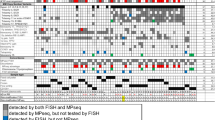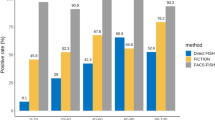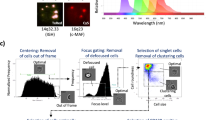Abstract
In diagnostic evaluation of effusions, difficulties are encountered when atypical reactive mesothelial cells have to be differentiated from malignant cells. We tested the impact of fluorescence in situ hybridization (FISH) to identify metastatic cells in breast cancer effusions by detection of numerical chromosomal changes. Pleural and ascitic fluid samples (n=57) from 41 breast cancer patients were concomitantly evaluated by routine cytology and FISH, using centromere-specific probes representing chromosomes 7, 11, 12, 17 and 18. After setting stringent cut-off levels deduced from non-malignant control effusions (n=9), the rates of cells with true aneuploidy were determined in each effusion sample from breast cancer patients. The occurrence of aneuploid cells, as detected by FISH and indicative of malignancy, was correlated with the cytological findings. Routine cytology revealed malignancy in 60% of effusions. Using FISH, aneuploid cell populations could be observed in 94% of cytologically positive and in 48% of cytologically negative effusions, thus reverting diagnosis to malignancy. To confirm malignancy in cases with a low frequency of aneuploid cells, two-colour FISH was additionally performed and indeed showed heterogeneous chromosomal aneuploidy within single nuclei. We conclude that FISH is a valuable tool in the diagnosis of malignancy and may serve as an adjunct to routine cytological examination, as demonstrated here for breast cancer effusions.
This is a preview of subscription content, access via your institution
Access options
Subscribe to this journal
Receive 24 print issues and online access
$259.00 per year
only $10.79 per issue
Buy this article
- Purchase on Springer Link
- Instant access to full article PDF
Prices may be subject to local taxes which are calculated during checkout
Similar content being viewed by others
Author information
Authors and Affiliations
Rights and permissions
About this article
Cite this article
Zojer, N., Fiegl, M., Angerler, J. et al. Interphase fluorescence in situ hybridization improves the detection of malignant cells in effusions from breast cancer patients. Br J Cancer 75, 403–407 (1997). https://doi.org/10.1038/bjc.1997.65
Issue Date:
DOI: https://doi.org/10.1038/bjc.1997.65



